Day 7
When my alarm went off this morning at 5 am, I hopped up and headed downstairs to meet up with Dr. Lieberman and Stanley for a run, but found them heading into the lobby, dripping with sweat! They had just completed a 5-mile “warm-up” run. So, tired and baffled by the sleep habits of Dr. Lieberman and Stanley, I joined the two, and we headed back out to the streets of Kampala. During the duration of my 3.3-mile run, Dr. Lieberman passed me about 4 more times. Nonetheless, I slowly but surely made it to the finish line.
The pace didn’t slow at the hospital. With Ward 7 now equipped with a second C-arm, we could run two full ORs. Our plan for the day was ambitious. We scheduled six surgeries for the day. To make that happen, we skipped the morning lecture and aimed for a 7:00 a.m. start. Thanks to strong coordination between the U.S. and Ugandan teams, our first incision was made at 8:30 a.m.—a major improvement from the previous days.
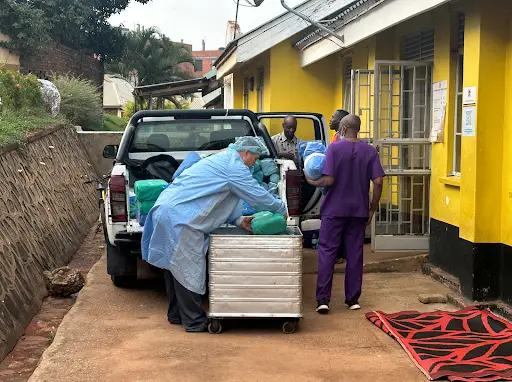
Rob and Godfrey loading up a cart to transport the surgical kits to the ORs.
- In Ward 7, Dr. Hisey began a posterior spinal fusion (L3–L5) for a patient with L3/4 subluxation and an L4 compression fracture.
- In the Spine Theatre, Dr. Lieberman operated on a patient injured in a motorcycle accident, performing an L2 corpectomy and posterior instrumentation (L1–L3) for an L2 burst fracture.
While the first two surgeries of the day were underway, Stanley and I made our rounds in the spine ward. Our main goals were to check on the post-op patients from the day before and ensure that we had collected all necessary pre- and post-operative imaging. With six surgeries scheduled and an ever-moving lineup of patients, keeping everything updated and accounted for was essential.
One of the biggest learning curves for me on this trip has been figuring out how to take proper medical notes. In school, I have never considered the organization or clarity of my notes. Meaning they could be messy or unorganized. I was the only one who had to understand them. However, patient notes are meant for my team to understand, so disorganization is not an option. Patient notes need to be clear, structured, and legible so anyone on the team, from Dr. Lieberman to the Ugandan residents, can quickly understand what is going on with a patient at a glance.
Up to this point, I had been taking so much time to make sure all of our patient files were updated and hadn’t spent a lot of time in the ORs. So, I made it a point to watch Dr. Hisey’s second case, an ACDF in Ward 7, where they decided they were going to listen only to Broadway musicals! Toward the end of the procedure, after a clean C-arm image, Dr. Kenneth, the Ugandan attending, proudly declared that Dr. Hisey was officially “on fire.”
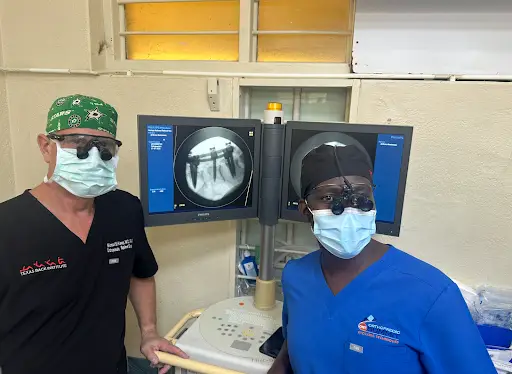
Dr. Hisey and Dr. Kenneth posing in front of their patient’s final X-ray!
Meanwhile, Dr. Lieberman’s first case was running longer than expected. So, in order to stay on schedule, we readjusted the order of the next operations. Dr. Hisey would take on the posterior spinal fusion originally planned for the 3rd case in the Spine Theatre, and Dr. Lieberman would finish his day with Dr. Hisey’s 3-level decompression instead. Quick changes like this once again reiterated the importance of being able to adjust on the fly and remain flexible.
That said, as soon as Dr. Lieberman finished his case, we had to pivot once again. His next patient—a 14-year-old boy—had developed a fever and could no longer safely undergo surgery. His case would have to be postponed to Friday, pending improvement. So, just as quickly as we switched cases, we switched them right back. Dr. Lieberman was once again going to take over the PSF as originally planned, and Dr. Hisey would complete the 3-level decompression.
Now, we could start working on the schedule for Friday, our last day of operations.
Setting the next day’s surgical schedule is a detailed process that requires coordination across the entire team. Here’s what it typically looks like:
- Confirm the cases and order with Dr. Lieberman, Hisey, and Stanley.
- Assign locations for each case and determine which surgeon will operate in which OR.
- Finalize the order of operations for each OR.
- Check with Rob and Sadie (equipment technicians) to confirm which instrument sets are available.
- Get surgeon approval on which kits will be needed for which procedures.
- Communicate the plan back to Rob and Sadie so they can prep the required trays.
- Double- and triple-check every detail of the finalized schedule.
- Share it with both the Ugandan and U.S. teams so everyone is aligned.
Going through the process of scheduling patients has helped me to appreciate the value of front-end organization. Taking the time to plan carefully early on pays off in a big way when things inevitably get chaotic later. Just as importantly, I’ve learned that the ability to clearly and efficiently communicate across different teams is not just helpful—it is essential to making a mission like this run smoothly.
With Dr. Hisey’s third case wrapped up, we were just waiting on Dr. Lieberman to complete his final case in the spine ward before officially calling it a day.
Unfortunately, it involved a complication we’ve seen far too often on these trips: severe bedsores. Patients, often paralyzed, can’t reposition themselves, and in many cases, have no family present to help. So, they remain on their backs for weeks or even months. Pressure ulcers form and eventually become infected. It is frustrating to see this, considering how easily preventable they are.
Despite encountering unpreventable scheduling issues and challenges like bedsores, I think it’s important to highlight the good we see, as well. Sometimes it’s the simplest gestures—like handing out lollipops—that bring the biggest smiles. On this particular night, Edwin solved and gifted a Rubik’s Cube to the young patient who had come down with a fever earlier in the day. The young boy’s smile expressed his gratitude and far outweighed any of the day’s challenges.
Once the Spine Theatre was cleaned up and the final case was finished, we packed up and headed back to the Koki Hotel for dinner. Tonight’s buffet included fish curry, vegetables, beef, the now-famous chicken pizza appetizer, which was more than enough food to refuel after our busiest day yet.
We wrapped up the evening as usual—sharing our quotes and lessons of the day, laughing through stories, and finally making our way upstairs to rest. Tomorrow would be our final day in the OR.
Day 8
It didn’t feel real that we were already at the end. After a whirlwind week of surgeries, teaching, and long days on our feet, we woke up to our last day in the ORs—grateful for the time we’d had, and ready to finish strong.
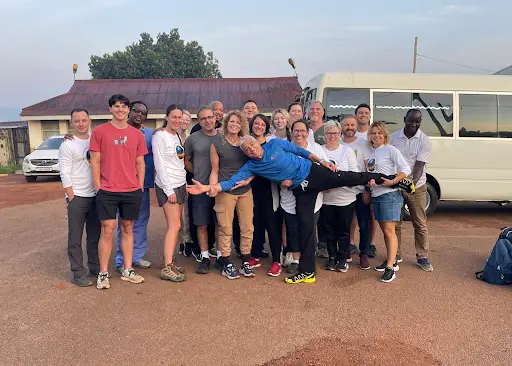
The team arriving at the hospital for one last day of operations!
When we made it to the hospital, we knew exactly what to do. The OR teams fell quickly into rhythm. While the rooms were being prepped, Dr. Lieberman, Dr. Hisey, Stanley, and I made rounds through the spine ward. The message for most patients was clear—either they were ready to be discharged or it was time to start get them up and mobilizing.
It was during this last round that the realities of postoperative care in Uganda hit me once again. What these patients go through is unimaginable compared to the standard of care in the U.S. Families—not nurses—are the primary caregivers. They feed, clean, and physically move patients, often with no training and minimal support. For patients with paralysis, the outlook is grim without a robust support system. Stanley put it plainly: it’s not the operation that puts these patients at risk—it’s what comes after. Immobility leads to infected bedsores; loss of bladder and bowel function leads to UTIs and sepsis. Without proper care, the odds are stacked against them, especially after we leave.
Despite this, there is immense gratitude. No complaints. No anger. Just hope. And maybe that’s what our presence brings more than anything: a renewed sense that things can get better. Seeing patients smile post-op has been healing in ways I didn’t expect—for them and for me.
We had four final cases scheduled for the day. In Ward 7, Dr. Hisey began a 360° fusion for a patient with L5/S1 degenerative spondylolisthesis. Dr. Lieberman assisted with the anterior exposure for the ALIF portion of the procedure—something few spine surgeons still do themselves—but due to dense scarring, the team had to pivot and proceed with a TLIF instead. Meanwhile, in the spine ward, Dr. Lieberman started a posterior spinal fusion (T3–T12) for a young patient with kyphoscoliosis.
While those cases were underway, Stanley and I raced around the hospital gathering final pre- and post-op imaging. Since some of the patients did not have pre-op imaging, Rob took a few minutes to show me how to operate the C-arm’s files to access intraoperative patient scans, which was one of the coolest things I learned all week.
Later in the day, we moved into our final two cases. In Ward 7, we returned to the young patient whose surgery had been postponed the day prior due to fever. With his temperature now stable, the team successfully performed a T3–T8 posterior spinal fusion with a decompression at T6. At the same time, Dr. Lieberman began our final operation of the entire trip—a direct lateral L2 corpectomy and posterior instrumentation from L1 to L3 for a patient who had suffered acute back pain after a fall.
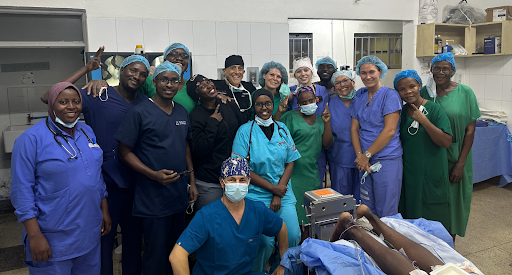
All of the team members working the final case of the trip in the Spine Theatre.
As the last few cases wound down, we began saying our goodbyes to the Ugandan staff. This moment hit me harder than I expected. Last year, there was often a sense of friction—miscommunications, tension, a subtle sense of outsiders stepping into a space that wasn’t quite ready to receive us. This year felt entirely different. We were welcomed with open arms, huge smiles, and genuine collaboration. These weren’t just colleagues now—they were friends. We shared laughter, stories, and pictures. It felt like a real team.
As Dr. Hisey wrapped up his final case of the trip, the Ward 7 team—self-dubbed the “Magnificent Ward 7 Warriors”—snapped a quick photo to mark the moment. In the spine ward, Dr. Lieberman’s last case ran long into the night, not finishing until nearly 9:30 p.m. No one complained. Everyone stayed focused, committed to closing out the week on a high note.
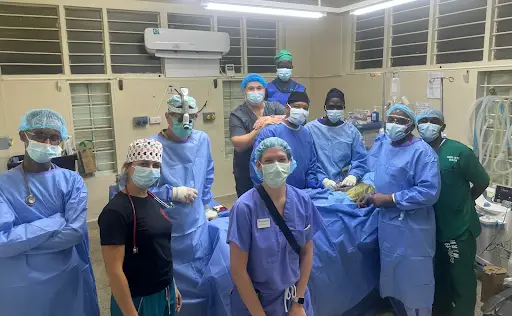
The self proclaimed “Magnificent Ward 7 Warriors” celebrating the completion of their final case!
Back at the core, we sorted supplies—what to take home, what to store, and what to leave for our Ugandan partners. At 10:20 p.m., exhausted but proud, we climbed onto the bus one last time and headed back to the Koki Hotel.
20 surgeries in 6 days. Countless lives touched. And memories that will stay with us long after we return home.

